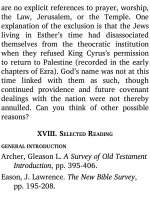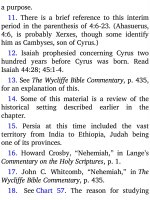Jensens survey of the old testament adam 80
Bạn đang xem bản rút gọn của tài liệu. Xem và tải ngay bản đầy đủ của tài liệu tại đây (186.93 KB, 4 trang )
Within the group of the Pentateuch books,
Deuteronomy resembles Leviticus in its
paucity of action sections. The books are
also similar in that the instructions
contained in each were given to Israel while
they were in standby encampment—at Sinai
(Leviticus), and on the plains of Moab
(Deuteronomy). In Leviticus they were
anticipating their wandering life, and in
Deuteronomy
they
were
making
preparations for their settled life in Canaan.
The two books are di erent in that Leviticus
was given mainly for the instruction of the
priests and Levites, while Deuteronomy was
given to instruct the Israelite laymen.
Deuteronomy also supplements, by
additions or explanations, some of the things
already recorded in the earlier books. For
example, in Numbers we are told that elders
were appointed to assist Moses, but the
instructions that Moses gave these judges at
that time are recorded in Deuteronomy
(1:16-17). Also, in Numbers we are told that
the spies were sent from Kadesh-barnea, but
not until Deuteronomy 1:19-23 do we hear
of the request originating with the people.
Further, in Numbers, Moses was forbidden
to enter Canaan, but the conversation
between him and God is not recorded until
Deuteronomy 3:23-26.
III. SURVEY
1. Scan the book of Deuteronomy for rst
impressions. Include in the scanning the
reading of the first verse of each chapter and
the topic headings shown at the top of your
Bible. Do not get bogged down in any
details along the course of this quick
reading. Read more for overall impressions,
trying to sense the atmosphere of Moses’
message. Scan the book a second time, more
slowly. Record a title for each chapter of the
book on paper. (Note that Chart 27 begins a
segment at 4:44 instead of at 5:1. Read the
Bible text and account for the division at
this point.)
2. Compare the beginning and end of the
book by reading 1:1-8 followed by 34:1-8.
What are some of your observations?
3. Read 1:1—4:43, underlining strong
words and phrases as you read. In chapters
1-3, of what is Moses reminding the people?
(Observe the repeated word “Then.”) How
do those three chapters lead up to what
Moses says in 4:1-43? Underline in your
Bible all the imperative words which Moses
spoke in chapter 4 (e.g., “listen,” 4:1; and
“keep,” 4:6). How are chapters 1-4
represented on the survey Chart 27? Use
Chart 25 as an outline guide for your study
of these chapters.
4. Note on Chart 27 how the division 4:44
—26:19 is identi ed. In 4:44—11:32, Moses
expounds
and
applies
the
Ten
Commandments. In what chapter are those
Ten Commandments quoted? How does
11:26-32 conclude this section?
5. In chapters 12-26, Moses cites related
commandments which the people were to
obey in their daily walk. Read these
chapters. Observe the repeated phrase, “the
LORD your God” in these chapters. Why did
Moses not say “the LORD our God”? Read the









